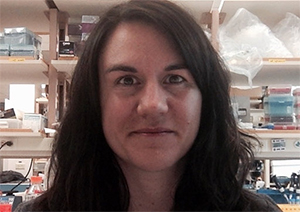2019 CIHR Early Career Investigators in Maternal, Reproductive, Child and Youth Health Grant Profiles
| Profile: |
|---|

Perinatal complications and outcomes in female survivors of adolescent and young adult cancer: a population-based study on the impact of cancer on pregnancy in CanadaName: Miranda M Fidler-Benaoudia Each year, approximately 7,600 adolescents and young adults (AYAs; 15-39 years) are diagnosed with cancer in Canada. These individuals fall between childhood and adult cancer care programs, and have complex needs because they were diagnosed with cancer during critical developmental, social, and reproductive years. A primary concern among AYAs with cancer is fertility. Because more women are having children later in life, many AYA patients will not have had a child when they are diagnosed with cancer. Previous research has found that cancer therapies can lead to high-risk pregnancies or infertility, and thus the possibility of having future children after cancer is uncertain for these survivors. To date, limited information is available to guide women and doctors about pregnancy after cancer at a young age. In this study, we will look at the impact of cancer on subsequent pregnancy complications and outcomes. Using a Canadian cohort of AYA cancer survivors, we will assess: 1) the rate of abortions, stillbirths, and live births, 2) the degree of complications in mothers and newborns, and 3) whether risks of these complications and outcomes change with time from diagnosis or treatment period. These points will also be explored using more detailed data from Alberta to establish the effect of radiotherapy and chemotherapy treatment, and develop recommendations for doctors. The results of this study will add to the current understanding of pregnancy after cancer, and will inform survivors, health professionals and researchers. By identifying key risk factors for these reproductive late effects, we will provide critical evidence to build risk stratification models for clinical guidelines, which can then be used to screen AYA cancer survivors and ultimately determine who needs further investigation, intervention, or support in relation to fertility. Twitter: Website: Miranda Fidler Benaoudia |

Total liquid ventilation for bronchopulmonary dysplasia prevention in a model of extreme preterm lambName: Dr. Étienne Fortin-Pellerin Modern medical care allows for more extremely preterm-born babies to survive. These patients have immature lungs that tend to collapse and render breathing extremely difficult. Despite efforts to avoid mechanical ventilation, most of these babies will require such support in the first few days of life. The use of a gas ventilator to ensure their survival generates inflammation that damages the lungs. Unfortunately, most babies born before the 25th week of pregnancy that survive will develop chronic pulmonary disease, called bronchopulmonary dysplasia. Altered lung function and neurological development are now clearly associated with this chronic lung disease developed after a preterm birth. Total liquid ventilation, where the lungs are filled and then ventilated with a liquid called perfluorocarbon, has been proven to lower inflammation induced by ventilation and could be useful to prevent lung damage. A ventilator developed by our INOLIVENT team at the ‘Université de Sherbrooke’ allows for the precise control of liquid ventilation parameters. We can thus now refine liquid ventilation techniques in order to use this advanced respiratory support on the premature infant to reduce lung damage and potentially prevent bronchopulmonary dysplasia. Our multidisciplinary team has already put in place the techniques to assess the effect of different liquid ventilation strategies on the heart and lung and to evaluate the inflammatory response using a term lamb model. The aim of the current project is to use a preterm lamb model to evaluate the clinical potential of total liquid ventilation to limit lung inflammation induced by mechanical ventilation when compared to conventional gas ventilation. Bronchopulmonary dysplasia has been a concern for neonatologists for the past 50 years, and we believe the refinement of conventional gaseous mechanical ventilation has reached its limits. We came to the conclusion that commitment to total liquid ventilation is the way forward to solve this lingering problem. Website: Research Group Inolivent |

Improving health outcomes and coordinating care for children with complex health and social needsName: Dr. Jennifer D Zwicker “I understand the system needs to focus on fiscal needs. But, I wish [decision-makers] could look at the bigger picture. Their fiscal needs will be met…by addressing parental mental health, by providing adequate child healthcare, by understanding that the time and focus I need to care for my child takes away from my ability to fill my potential[as a caregiver and contributor to society].” – Quote from parent of child with NDD and medical complexity (preparatory interview, 2018) For children with medical complexity and neurodevelopmental disability (NDD), fragmentation of service delivery negatively impacts their health outcomes, family functioning and quality of life, and often leads to inappropriate and inefficient healthcare utilization. The majority of children with NDD have some medical complexity and the responsibility for care coordination falls largely to the family. This project aims to address fragmentation of services, utilizing economic evaluation and policy analysis to evaluate the scale and spread of care coordination services for children with medical complexity and NDD. Our team will evaluate the impact of the NDD care coordination project (in Calgary, AB), which uses a care coordination framework (with defined roles, services, activities, processes and strategies) and an established care coordination curriculum to guide project processes and ensure a systematic approach, involving identification, engagement, coordinated service delivery, family empowerment, monitoring, transition and follow up. Using a quasi-experimental pre-post design with a nonequivalent control group we will: 1) measure the impact on child and caregiver quality of life 2) examine health service utilization and costs 3) obtain perceptions of stakeholders on the role of care coordination in improving access to services and outcomes, to inform the spread and implementation of the model. Evidence-based policy recommendations emerging from this study will inform the design of other coordination systems to ultimately help children with medical complexity and their families thrive. Twitter: @jdzwicker Website: Jennifer Zwicker |

The role of age of cannabis use onset in the developmental pathways leading to substance use problems by early adulthood: key mediators and moderatorsName: Dr. Natalie Castellanos Ryan One in three Canadian youth in the 16-25 years of age group are active cannabis users, with statistics showing that trends in cannabis use (CU) are rising. This is worrying as some studies have shown that CU during adolescence is associated with higher risk for adult cannabis and other substance use disorders. However, it is still unclear whether starting CU earlier in adolescence puts youth at higher risk of developing later substance use problems after accounting for early risk factors or different patterns of substance use. We also don’t know what individual and environmental factors place boys and girls who initiate cannabis use during adolescence at higher risk of developing later substance use problems. Thus, the present project aims to examine (1) whether the association between CU initiation and later substance use problems remain when considering important environmental and individual factors; (2) whether the association between early CU initiation and later substance use problems can be explained by CU profiles (how much one uses, how frequently, etc.) and individual and environmental characteristics, and (3) whether the effect between age of initiation and later substance use problems differ for different CU profiles, and individual and environmental factors. For this, we will build on an ongoing longitudinal study, in which participants were followed from age 5 months to 18 years, and we will collect detailed information on their cannabis use and other substance use, mental health, and the youth’s environment at 23 and 25 years. This study could provide much needed information about how individual and environmental factors work together to increase the risk of developing substance use problems, potentially helping guide policy and prevention for those more likely to develop substance use and other problems by early adulthood. Key Publications:
Twitter: Websites: |

Value for money: A mixed methods study to investigate the impact of funding expanded midwifery care models in CanadaName: Dr. Elizabeth K Darling (Dr. Liz Darling) Birth is costly. About 10% of hospital costs in Canada are for giving birth or being born in a hospital. Canadian research suggests that midwives can provide birth care at lower cost while still ensuring good health outcomes. Midwives help lower costs because they are less likely to use costly interventions, the people they care for leave hospital earlier, and they attend some births at home. Until recently, the way midwives have been paid has limited the ways in they can work within Canadian health care systems. Our research will take advantage of a natural experiment that involves funding midwives in Ontario to work in new models of care, providing a wider range of services, and working in settings that they have not previously worked in. Our research will explore the value for money that has been achieved through this new funding in three ways. One, we will interview patients, health care providers, administrators, and policy-makers to identify what they see to be the value of the new funding and the programs it funds. Two, we will analyze the costs of the new alongside midwifery unit to learn whether the new funding supports a lower cost model of hospital-based midwifery care. Third, we will develop a framework that can be used to examine the costs and cost savings of programs that target people who are at risk of poor access to health care and poor health outcomes, and we will use this framework to evaluate the costs of one of these programs. Our findings will be valuable for Canadian policy-makers and hospital administrators to inform health system policy and hospital planning on the most appropriate use of resources to optimize health outcomes. Twitter: @LizDarlingRM Website: Liz Darling |

Optimizing preterm delivery time: brain health & neurodevelopmental outcomes - Promoting healthy outcomes in preterm babiesName: Dr. Emma Duerden Preterm birth is a leading cause of still birth and childhood disabilities in Canada. With advances in medical care, the number of babies being born early has increased significantly. Much of this change is related to medical decision making, where babies are delivered early to minimize birth complications. For fetuses who are restricted in their growth, typically due to a failing placenta, early delivery can prevent serious illness or death. Placental failure causes decreased oxygen supply to the brain and places fetuses at high risk for brain injury and cerebral palsy. Presently, doctors lack tools to determine when the fetal brain is at greatest risk for injury and which babies need to be delivered early. Developing sensitive imaging tools that can predict brain injury in growth-restricted babies are needed to inform delivery time and promote healthy outcomes. Presently, the decision to deliver a baby who is growth restricted is largely based on ultrasound. While this technology is inexpensive and can be done at the patient’s bedside it can only provide limited measurements about blood flow to the fetal brain. Altered blood flow patterns reflect blood being directed away from major organs in order to protect the brain, known as ‘brain sparing’. When brain sparing occurs, the fetal brain is at risk for injury to key white and grey matter regions in the brain that underlie cognitive and motor abilities. The long-term goal of this research is to address this critical need for obstetricians to develop better MRI-based methods to monitor growth restricted babies at risk for brain injury while still inside the womb, to improve newborn brain health and prevent developmental difficulties in learning and motor skills. Presently, no therapies or interventions are available for growth restricted fetuses, so the focus on prevention of neonatal brain injury is key to improving outcomes in this vulnerable population. Key Publications: Emma Duerden: Publications Twitter: @developingbrai1 Website: Developing Brain Lab |

Identifying premorbid environmental and neural markers of risk for first lifetime onsets of depressive and anxiety disorders in high-risk youthName: Dr. Daniel Kopala-Sibley My research pertains to the influence of developmental experiences (parenting in particular, but also peers and life stress in general) on change over time in personality and brain functioning in youth, and how these factors interact to influence risk for depressive and anxiety disorders. Given that having experienced a prior episode of depression or anxiety is one of the strongest predictors of experiencing a subsequent episode, I am particularly interested in understanding how developmental experiences, personality, and brain functioning predict the first onset of internalizing psychopathology. I also aim to examine how these factors interact with other biological aspects of risk for internalizing psychopathology, such as candidate genes, markers of inflammation, and neuroendocrine functioning (e.g., cortisol). The primary project in my lab will examine predictors of the onset of first-episode depressive and anxiety disorders in a large sample of early adolescents who have at least one parent with a history of these illnesses, and who are therefore at high risk for depressive and/or anxiety disorders themselves. In particular, this project will focus on parenting, personality, life stress, and neural markers of emotional and reward processing as well as cognitive control (assessed via fMRI) as predictors of the onset of depressive and anxiety disorders. Results from this project will aid identification of and inform interventions for youth who are risk for the development of personality traits and markers of brain functioning that put them at risk for mental illness prior to actually developing this risk. Twitter: Websites: |

The Par Polarity Complex in the Pathogenesis of PreeclampsiaName: Dr. Meghan Riddell The placenta is a fetal organ that is present only during pregnancy. The proper formation and function of the placenta is important for health, with malfunction in the placenta causing pregnancy complications such as preeclampsia, a dangerous condition where a mother develops high blood pressure in the second half of pregnancy. The syncytiotrophoblast, a cell that covers the surface of the placenta, is especially important in the development of preeclampsia. It serves as the exchange site between the mother and the fetus where nutrients are moved from the mother’s blood to the fetus. Therefore, it must know which side faces the mother’s blood and which side is closer to the fetal blood. This is called cell polarity. Cell polarity ensures that the right pieces of a cell are in the right place so it can perform functions like transporting nutrients. We know in preeclampsia that the cell polarity of the syncytiotrophoblast is different than in normal placentas, but how this cell establishes and maintains polarity has never been studied. In this project, we will examine a group of proteins called the Par polarity complex in the placenta. The Par complex is known to control polarity in other cell types. Therefore, we will test whether they also control polarity in the syncytiotrophoblast. This group of proteins is also known to help cells sense inflammation. Inflammation is also known to cause preeclampsia. Thus, in addition, we will test whether the Par complex controls the reaction of the syncytiotrophoblast to inflammation. This project will identify how processes that are disrupted in preeclampsia occur in healthy placentas so that we can identify what may go wrong to lead to the development of preeclampsia in the future. Twitter: Website: Meghan Riddell |

A prospective study evaluating complement activation in pregnant women with antiphospholipid syndromeName: Dr. Leslie Skeith Antiphospholipid syndrome (APS) is a rare autoimmune disorder and acquired blood clotting condition. Pregnant women with APS are at risk of blood clots, and have high rates of pregnancy loss and other complications despite receiving anticoagulation during their pregnancy. We still don’t know why these pregnancy complications happen or the best way to prevent them. The complement system is made up of different proteins in the blood and is part of the body’s immune system. What causes APS is poorly understood, but involves abnormal complement system activation. We are studying whether problems in the complement system may explain the pregnancy complications and blood clots that happen to pregnant women with APS. This is a multicentre prospective cohort study that will follow pregnant patients with APS and a healthy control group throughout pregnancy. We will measure complement activation over time in both groups, and will test for underlying genetic mutations related to complement. We will use what we learn from this study to better identify who with APS is at risk of developing pregnancy complications and how we can better study targeted therapies to improve maternal and neonatal outcomes. Twitter: |

Encouraging Informed Decisions about Using Cannabis During Pregnancy and BreastfeedingName: Dr. Meredith Vanstone Recreational use of cannabis has been legal in Canada since 2018; Medical use has been legal since 2001. More and more Canadians are choosing to use cannabis for both recreational and medical reasons. Some women use cannabis during pregnancy and breastfeeding, especially if they were regular users before pregnancy. There is evidence that using cannabis during pregnancy may cause babies to be born early, have low birth weight, and have some impairments in the way their brain develops. However, the medical evidence on this is uncertain and some studies have found no association between cannabis use and these negative outcomes. For women who are only occasional users, this may be a good enough reason not to use cannabis at all during pregnancy and breastfeeding. However, there are many reasons that other women may struggle with abstaining from cannabis use during pregnancy and breastfeeding. Some may not understand the potential harms. Others who used cannabis to treat certain conditions before pregnancy may wish to continue this use. Some may choose to use cannabis as a way to stop using other, more harmful substances like opioids. Others may start to use cannabis during pregnancy in order to treat their morning sickness. Because of the stigmatization of cannabis use in pregnancy, women may not feel comfortable talking with their health care providers about this. Health care providers may be uncertain what advice to offer, since the evidence about cannabis is so undeveloped, and many women have compelling reasons to use. This research will examine how women make decisions about cannabis use during pregnancy and breastfeeding, offering social and ethical evidence to help prenatal health care providers counsel about this challenging issue. Twitter: Websites: |

Epigenetic changes linking prenatal exposures to tobacco or cannabis smoke with asthma riskName: Dr. Meaghan J Jones |

The mental health impact and needs of those living with food allergy: Perceptions from children, parents and care providers to inform a needs-based multi-faceted support programs and policyName: Dr. Jennifer L Protudjer For the 4-8% of the population worldwide with food allergy, selecting what and where to eat can be challenging, and in the event of an accidental exposure, potentially fatal. To prevent a reaction, allergic individuals must exclude the foods to which they are allergic. This can be challenging, socially limiting and costly. The most acute consequence of food allergy is anaphylaxis, a severe and potentially fatal reaction, which must be treated with epinephrine and for which emergency care must be sought. Under The Canadian Charter of Rights and Freedoms, anaphylaxis-level allergy constitutes a disability, which makes schools obliged to accommodate these allergies. Yet, at present, there are no national policies to support those with food allergy. The major goal of our project is to describe the impact of food allergy-related mental health, through the voices of those directly impacted (children, parents, healthcare professionals, teachers) and by using administrative healthcare records, in order to inform the development of needs-focused pediatric food allergy support programs and policy for children and their families, and schools. The planned studies follow a mixed methods design, with concurrent, yet independent collection of qualitative and quantitative data. Subsequently, all data will be converged at the interpretation stage, at which point a meta-inference will be created. We will use this meta-inference to create a patient-centered, needs-based food allergy education program that acknowledges the needs and restrictions of children, their parents and the larger community. The collective impact of our project will help inform decisions for maximizing available resources, providing optimal care for those with food allergy, while also respecting the larger community, and for future planning. Key Publications:
Twitter: Website: |

Improving suicide assessment and intervention with children: A participatory action research project informed by children's experiencesName: Dr. Marjorie Montreuil Children’s suicide risk has dramatically increased over the past 40 years. According to Statistics Canada, in 2017, suicide represented the 7th leading cause of death in children between the ages of 5 and 9, and is the primary cause of death in children between the ages of 10 and 14. While suicide in children remains a persistent issue, this age group has received considerably less research attention than their adolescent and adult counterparts. In addition, few studies have examined the experiences of children regarding the care they received for suicide prevention. Since child patients are the receivers of care, they are in a unique position to comment on the effectiveness of suicide prevention care. They represent an untapped source of valuable knowledge to improve suicide prevention and mental health care. Furthermore, inquiring the insight of children will produce valuable information regarding their clinical needs, goals, and preferences to improve suicide prevention. The objective of this project is to gain a better understanding of the experiences of children who have received suicide prevention care and improve the care offered to children. We seek to: (1) Increase our understanding of the care received by children at risk for suicide; (2) Identify children’s needs, goals and preferences in relation to suicide prevention care, from their own perspectives; (3) Inform the adaptation of a suicide assessment and intervention tool to children’s needs, goals and preferences; and (4) Assess the tool. Key Publications:
Twitter: @McGillNursing Website: Marjorie Montreuil |

Microglia modulation to protect the developing brain after injuryName: Dr. Sophie Tremblay Cerebellar growth is highly vulnerable during the third trimester of pregnancy and could be affected by diverse insults leading to cerebellar growth failure and atrophy. Up to 19% of infants born extremely preterm will be affected by cerebellar injuries during their hospitalization. Despite a dramatic improvement of their survival and a major decrease in severe brain injury, almost 50% of infants born extremely preterm will suffer from long-term neurological impairments. This project will examine the key role of microglial cell responses to perinatal insult, which may protect cerebellar structure from damages and provide a neuroprotective effect. We will examine the role of the brain innate immune system, microglial cells, in hindering the cerebellum’s resilience to insult and prevent long-term cognitive deficits. In second, we will describe changes in inflammatory expression pattern from microglial cells induced by perinatal cerebellar injury. At last, we will test the potential therapeutic benefit of FDA-approved drugs known to modulate brain inflammation and reprogram pathological microglial responses. The focus has been so far mainly on protecting cerebral injury in infants born prematurely; but preventing cerebellar insults is as important and will result in significant neurodevelopmental improvement. Currently there is no therapeutic agent given routinely to prevent cerebellar injury affecting around 11 000 infants born extremely preterm in North America per year. Achievement of our goals will lead to expand the repertoire of potential therapies available to protect the developing brain a first step towards improved health outcomes of extreme preterm infants affected by cerebellar injury. Twitter: |

Unraveling the pathobiologies of pregnancy- and DGKE-associated renal thrombotic microangiopathiesName: Dr. Mathieu Lemaire Blood vessels are like roads used to deliver food and oxygen to our body. They are covered by a thin carpet of endothelial cells to help make sure that blood flow is smooth. When a vessel is injured, blood flow slows down so repair can happen, like a "good" traffic jam. It is critical to avoid clotting in healthy blood vessels, that is "bad" traffic jams. We study two diseases that both lead to abnormal clotting in the kidneys, causing kidney failure. We study them together because what we find for one disease can help understand the other disease. The first disease is called HELLP syndrome. It affects about 1% of all pregnant women and can be fatal for the mother and/or fetus. An injury to the placenta causes the clotting problem for the mother. The placenta sends a protein called sFLT1 in the mother's blood that triggers clotting in the kidney. Our goal is to better understand how sFLT1 causes this disease. The second condition is caused by severe mutations in a gene called DGKE. Affected children have kidney blood clots after minor infections up until age 5 and develop chronic kidney failure before adulthood. Of great interest, infections can cause the release of sFLT1 in the blood of patients. Our goal is to understand if sFLT1 released in the blood during infections triggers blood clotting in these patients with DGKE mutations. We will also investigate if mothers diagnosed with HELLP syndrome have DNA changes in DGKE that may explain why they developed kidney disease. A better understanding of how and why these two diseases occur is essential to develop new treatments. Anticipated outcomes include a better understanding of the pathophysiology of HELLP syndrome and DGKE nephropathy, insights into the genetics of HELLP syndrome, and development of novel therapies for HELLP syndrome and DGKE nephropathy to prevent or reduce the impact of thrombotic kidney lesions. Key Publications: Mathieu Lemaire: Publications Twitter: Website: Mathieu Lemaire |
- Date modified: